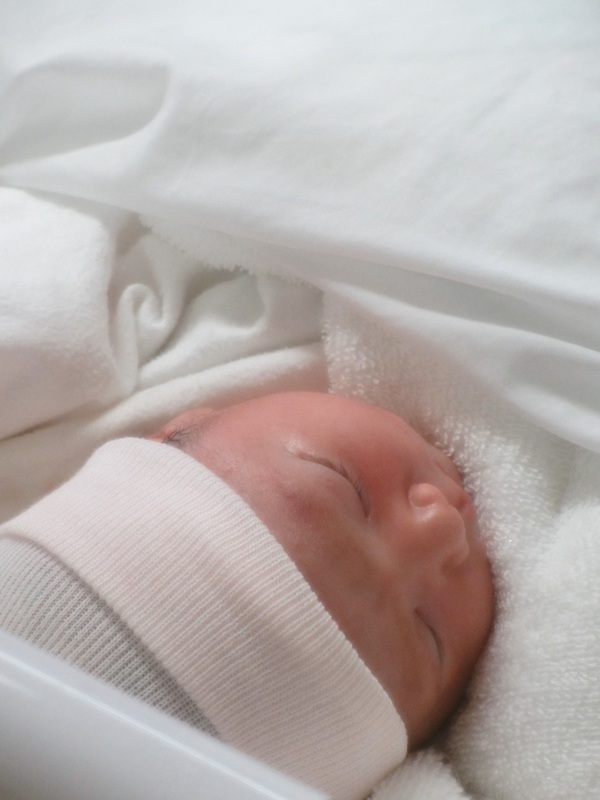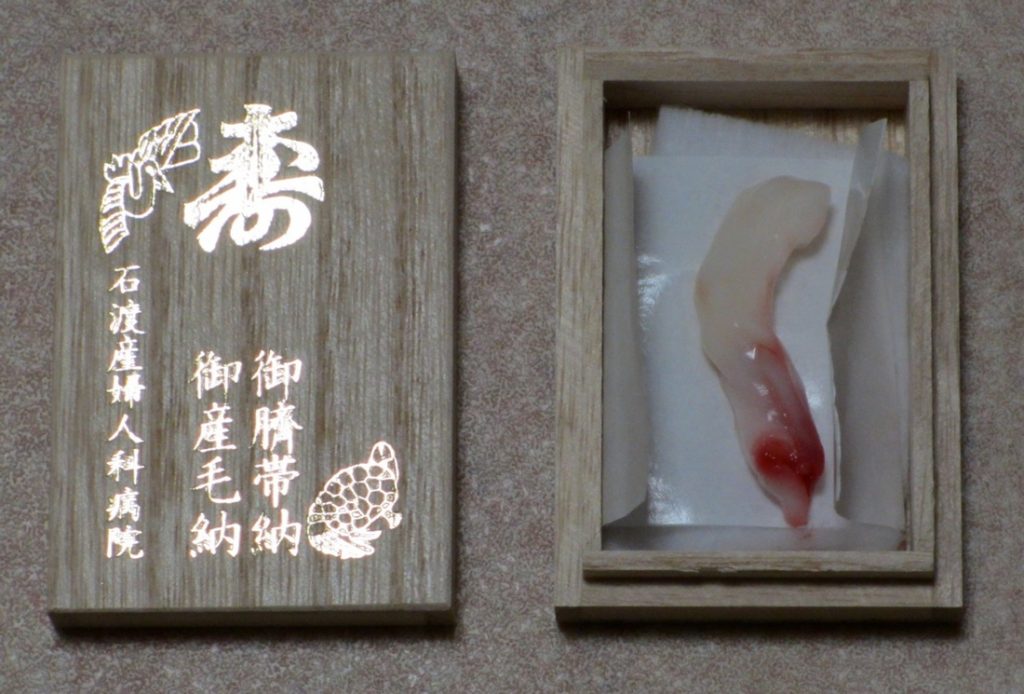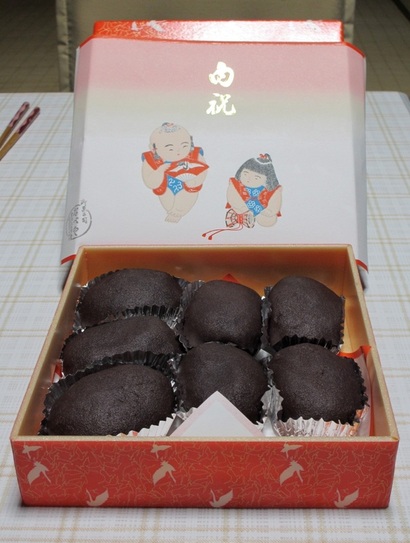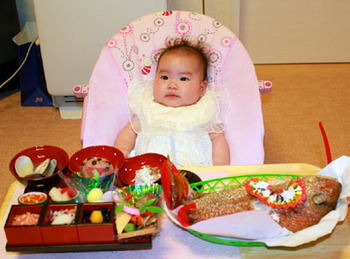
It has now been three weeks since M Jr was born, and as well as the usual parenting concerns – eg. How do I change a nappy? How do I tell when a bottle of formula has reached the correct temperature? Is it just me or does one of her ears stick out slightly further than the other one? – I have been trying my best to get up to speed with the various traditions and pecularities associated with having a baby in Japan.
Starting at the very beginning, here’s what I’ve managed to find out so far (although be warned, as some of these may be specific to Ibaraki, or subject to variation depending on which part of the country you happen to live in):
1) Moh-kohan ( 蒙古斑 / Mongolian spot)
Most East Asian babies, along with a few from isolated groups elsewhere in the world – Native Americans, for example, and East Africans – are born with a blue-green mark in the small of their back called a Mongolian spot. In most cases the mark disappears over time, although it occasionally persists until adulthood, or manifests itself elsewhere on the body (if you find your Mongolian spot embarrassing, like a tattoo, it can be removed with laser treatment). According to Wikipedia, Mongolian spots are sometimes mistaken for bruises in the West, and as a consequence, at least a few expat parents have been wrongly accused of hitting their children. M Jr has a small and rather faint Mongolian spot, although given that it’s at the top of her builder’s cleavage, I didn’t think a snapshot would be appropriate.
2) Mei-shin (迷信 / superstitions)
M Jr is both a lion and a dragon (Leo and Chinese year of the~ respectively), although we won’t know what her ketsu-eki-gata (血液型 / blood type) is for another year or so, which in Japan is rather akin to not knowing your own name. Even Mrs M, who is almost as cynical as me when it comes to things like star signs, will talk in all seriousness about how As are obsessive compulsive and ABs have split personalities, and isn’t it unusual that we ended up together despite me being a B and her being an O.
A rather more obscure superstition that I became aware of just recently is the roku-yoh (六曜 / six labels for the Japanese calendar). Originally imported from China, the roku-yoh designate each day of the year with varying degrees of good or bad fortune, and while they don’t really have anything to do with childbirth, I thought I’d share them with you anyway, in case, like me, you’ve ever wondered what all those strange kanji are next to the dates in your diary:
– Sen-shoh (先勝 / literally ‘before win’) – The morning of a sen-shoh day is lucky, but the hours between 2pm and 6pm are unlucky.
– Tomobiki (友引 / ‘friend pull’) – The morning is lucky, lunchtime is unlucky and the evening is very lucky. Tomobiki days are good for business dealings and lawsuits, but bad for funerals.
– Senbu (先負 / ‘before lose’) – The morning is unlucky and the afternoon is lucky.
– Butsu-metsu (仏滅 / ‘Buddha destruction’) – Very unlucky all day.
– Tai-an (大安 / ‘big safe’) – The most auspicious of the six, and thus a good day for weddings and the like.
– Shakkoh (赤口 / ‘red mouth’) – The time between 11am and 1pm is lucky, but the rest of the day is unlucky.
Despite being born at four in the afternoon on a shakkoh, M Jr seems to be doing well, although in future, we may decide to hold her birthday parties at lunchtime.
4) Héso-no-o (臍の緒 / umbilical cord)
Allowing a father to cut his baby’s umbilical cord is a recent development in Japan, and wasn’t even mentioned to me as a possibility when M Jr was born. A much older tradition dictates that the umbilical cord is given to the parents, who leave it to dry before placing it on the butsudan (仏壇 / Buddhist altar) or kamidana (神棚 / Shinto shrine) in the family home. Otoh-san, for example, still has both Mrs M’s and onii-san’s umbilical cords, and while we donated most of M Jr’s for medical research, a small part of it now sits in a little wooden box on the kamidana.

(In contrast to this, Bobby Orgon said recently on Sekai Banzuké that in his home country of Nigeria, the umbilical cord is believed to possess mysterious powers, and that rather than keeping it, a father takes his baby’s umbilical cord from the hospital and buries it where there is no chance of it ever being found.)
4) Mitsumé-no-botamochi (三つ目の牡丹餅)
Three days after her baby is born, it is customary for the mother to eat bota-mochi – rice cakes covered in red bean paste – and for her family to give them to friends and relatives when they pass on the news of the birth. Okah-san placed her order for bota-mochi almost as soon as M Jr had let out her first cry, and a couple of days later I took the day off work to drive okah-san around, handing out bota-mochi to our many aunts, uncles and cousins. The two main disadvantages of bota-mochi are that a) they’re not particularly appetising, and b) they’re made of mochi-gomé (餅米 / extra-sticky rice used specifically for making rice cakes), which in the past was thought to aid the production of breast milk, but which has recently been found to do the exact opposite.

5) Mei-mei-sho (命名書 / name scroll)
Also on the third day after the birth, the mei-mei-sho – on which are written the baby’s name, its status within the family (for example, whether it’s an older brother or a younger sister), its birthday and the name of the head of the household – is displayed on the butsudan, the kamidana or even the tokonoma (床の間 / the decorative recess in an old-style tatami room, which in a modern-day hotel or B&B is often home to the TV). When Mrs M was born, otoh-san hired a professional calligrapher to write her mei-mei-sho at a cost of over 10,000 yen, whereas this time round, he typed it on Microsoft Word and printed it on a sheet of A4 paper.
6) Shussan-todoké (出産届 / notice of birth)
It is necessary to give notice at the town hall within fourteen days of a birth, so that your baby can be included on the koseki-toh-hon (戸籍謄本 / family register), and also so that you can begin receiving kodomo-té-até (子供手当 / child benefit). In the process of doing this, Mrs M and I realised that while M Jr will be registered as living at Mrs M’s parents’ address, her hon-seki (本籍 / permanent residence) is about a kilometre away, on a now empty plot of land where her great-grandparents – otoh-san’s parents – owned a house before they passed away in the 1970s.
7) Toko-agé (床上げ, aka obiaké / 帯明け or possibly obiya-aké / 産屋明け)
Back in the days when home births were the norm and the child mortality rate was far higher than it is now, a party called oshichi-ya (お七夜 / ‘honourable seventh night’) was held to celebrate a baby reaching a week old. Nowadays mothers and their babies spend that first week in hospital, and are only allowed to check out when they’ve been given a clean bill of health. At this point, however, they are expected to spend a further two weeks at the mother’s parents’ house, and this twenty-one-day period is known as toko-agé.
The literal translation of toko-agé is ‘floor up’, and refers to the practice of keeping mother and baby’s futon laid out on the bedroom floor at all times. While grandma does the washing, the cooking and the cleaning – not to mention as much of the baby-minding as her daughter is willing to hand over – mother and baby stay indoors and avoid anything that involves the use of cold water (they are seen as being particularly vulnerable to catching colds and infections). Unfortunately for Mrs M, otoh-san didn’t quite catch on to the purpose of toko-agé, and packed her futon away every morning, thus depriving her of the chance of a siesta. Also, for someone who was going for a walk at least once a day until the evening before M Jr was born, being stuck indoors felt a little claustrophobic, so she moved back to our apartment after just seven days in hospital and seven days at home.
8) O-iwai / uchi-iwai (お祝い / 内祝い)
In the UK, a new arrival is the cue for a veritable frenzy of knitting – booties, blankets, little baby-sized jumpers and so on – but in Japan, the parents will instead be granted the gift of cold, hard cash. The word o-iwai – ‘honourable celebration’ – is used to describe all kinds of gifts, but the tricky thing for the recipient is what to give in return (uchi-iwai).
As okah-san explained to us, uchi-iwai should amount to at least half the value of the original o-iwai, and it is best to go for a nice, round figure. For example, to the friends and relatives who gave us 10,000 yen o-iwai, we will give uchi-iwai to the value of 5000 yen, and for the friends and relatives who gave us 5000 yen o-iwai, we will round up their uchi-iwai to 3000 yen. Many people order their uchi-iwai from gift catalogues, but to avoid disappointment, Mrs M and I will be giving shopping vouchers instead, and okah-san has insisted that we supplement these with an extra present of something edible, meaning that in some cases we will retain just 20 % of the original o-iwai.
The shopping vouchers are from a credit card company called JCB (nothing to do with the people who make mechanical diggers, I might add), and purchased at a branch of the electronics store Yamada Denki. One of Mrs M’s great aunts lives just down the road from Yamada Denki, but when Mrs M suggested dropping in to hand over the uchi-iwai straight away, okah-san said that under no circumstances must we do so until the twenty-one days of toko-agé were up (after all, Mrs M was officially supposed to be at home, napping on her futon and with okah-san waiting on her hand and foot).
OK, so that’s the stuff we’ve already done, but still to come – in the near future, at least – are:
9) Omiya-mairi (お宮参り / first visit to the shrine)
After thirty days (one website suggests thirty-one for a boy and thirty-two for a girl, but anywhere around the one-month mark seems to be OK), the baby is taken to the local shrine so its family can pay their respects to the ubusunagami (産土神 / god of one’s birthplace). In some cases, this is done a hundred days after the birth, and known as momoka-mairi (百日参り / hundred-day visit).
10) Okui-zomé (お食い初め / literally ‘honourable eat first’, aka momoka-iwai / 百日祝い)
Taking place a hundred days after the birth, okui-zomé is symbolic of the move from a milk-only diet to rinyu-shoku (離乳食 / solids), although unfortunately for the baby, the food on offer is strictly for adults. A variety of traditional dishes are laid out on the dinner table and then wafted under the baby’s nose – if it’s a boy, this is done by the senior male member of the family, and vice versa for a girl – before being eaten. Presumably the baby has to make do with a jar of Cow & Gate instead.

(Nb. This isn’t M Jr, just an anonymous Google picture search baby.)
11) Koku-seki (国籍 / Nationality)
While most Japanese citizens are only allowed to hold one passport, those of mixed parentage (who are referred to as haafu – ie. half-Japanese, half-foreign) are allowed to hold two until they reach twenty-two years of age. At that point they are supposed to choose which passport they want to keep, although many who retain their Japanese passport secretly renew the other at a later date. By the same token, some parents don’t bother registering their haafu baby with the relevant foreign embassy in the first place, effectively choosing Japanese nationality straight away.
Partly because so many foreigners went back to their home countries after the earthquake, immigration laws – or at least the way in which they are implemented – have been relaxed a little of late, so I have a feeling the one-passport-only rule may have been dispensed with by the time M Jr reaches her twentieth birthday. In any case, at some point in the next few months, Mrs M and I will apply to the Consulate-General in Hong Kong for M Jr’s British passport, which will cost about a hundred quid including postage, and last her for the next five years (by which time she will of course look utterly different from the photograph of Winston Churchill contained therein).
Is there a handy catalogue for foreign parents to tell them all these things, or do they have to research all of that? Maybe I never paid attention to these things, but I doubt that for Germany I could even list 3 or more bullet points. Give birth, go back home, register the baby and that’s that (unless you are religious, in which case baptism). Maybe I just missed all sorts of secret tradition memos, or, I suspect, the Japanese take this more seriously.
The Japanese do take this more seriously, I think, although not quite as seriously as they used to – apart from the legally required stuff like registering your baby at the town hall, it seems to be perfectly acceptable to bend the ‘rules’ of a tradition or adapt them to suit your situation.
The main difference between here and the UK seems to be that here, the baby is seen as much more vulnerable. In the UK we like to ‘toughen up’ babies (and mothers, for that matter) from quite early on, and to encourage them to be more independent. For example, a lot of British kids have their own bedroom before they reach their first birthday, whereas in Japan, they’ll sleep in the same room as their parents until they reach their teens.
“Until they reach their teens”? Remind me never to have kids in Japan!
Until they reach their teens? Remind me never to have kids in Japan!